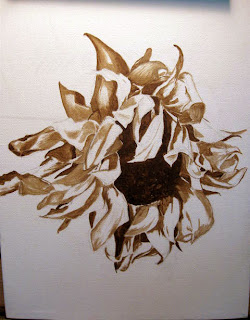I've said it before and I'm sure I'll say it again. Throw out your black paint. Any artist worth their brushes should be able to mix a black to suit their purposes without resorting to using something unnatural like Mars Black out of the tube.
Giving a tube of black paint in every starter set is a set up in my opinion. That, and they insist on including Veridian which is either the cheapest paint in the whole world to make, or else, someone out there is just trying to piss me off. Nothing is veridian and so many new artist just pick it up 'cuz that's the green it came with' and proceed to paint trees, grass, envy, whatever, straight out of the tube and result in landscapes with trees the color of interstate road signs and elementary school chalkboards. If you are painting one of those things, then Veridian is your gal, but if you're not... no touchy the Veridian.
But, I digress. My beef today is with Black. We've all seen those old men and women and angst ridden teens with hair dyed super-black. It's super-unnatural. No ones hair is pure black. No ethnicity has hair with no other tints or highlights whether they are red, blue or even greenish, but that fake black hair just looks like your grandmother's wig.
the reason is because, with few exceptions, nothing in nature is pure black. It's all made of other colors.
Have you ever tried to match black clothes? Of course. It's hard to do because those dyes are made of a base of one of the primaries, red, blue or yellow and those blacks after about 2 washes will start to take on the tone of that underlying color and your blueblack pants don't match your redblack shirt anymore.
In a painting, there are so many ways to make a rich black there is no reason to be so lazy, uncreative, or boring as to use black straight out of the tube.
Raw umber and French Ultramarine make a great black. a deep neutral black. So can many red and greens, blues and browns etc. Play around. Chances are, whatever purpose you think you want 'black' what you really want is really dark red, or blue, or brown. If you make a really dark red, blue or brown, while our eyes will interpret it as the darkest dark, the color, however 'black' in appearance will have undertones of warmth or coolness, or whatever attributes your mixing colors had. Here...look at this painting.

The background looks 'black', but it's about 10 glazed layers of a mix of raw umber, ultramarine and a few random glazes of blues and even a violet or so.
The resulting depth, while of course an illusion, looks like space and infinity rather than my grandmother's wig.
I'm just sayin'




